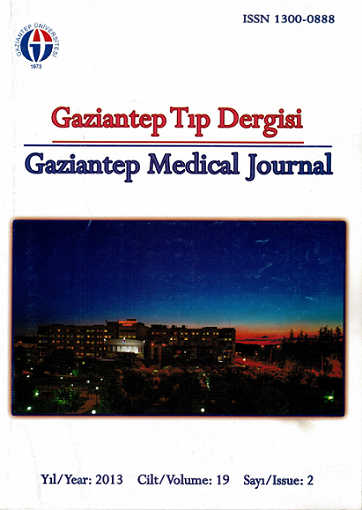Infantile pompe disease presenting itself with severe hypertrophic cardiomyopathy: three case reports
Ağır hipertrofik kardiyomiyopati ile kendini gösteren infantil pompe hastalığı: üç olgu sunumu
DOI:
https://doi.org/10.5455/GMJ-30-2013-132Keywords:
Children, hypertrophic cardiomyopathy, pompe diseaseAbstract
Infantile Pompe disease (glycogen storage disease type II) is a fatal disease that results from α glycosidase enzyme deficiency. Excessive undegradable intracellular glycogen deposition plays a role in the pathogenesis of the disease. Although excessive glycogen deposition involves many cells, clinical signs are limited mainly to the skeletal and cardiac muscle involvement. Therefore, it is a progressive disease that can cause death in early childhood due to extensive cardiomyopathy and weakness of respiratory muscles. We as well, aimed to present three cases, which had short P-R interval, large QRS complex and the signs of biventricular hypertrophy on ECG and prominent hypertrophic cardiomyopathy on transthoracic echocardiography in addition to respiratory muscle involvement.
Metrics
References
Kishnani P, Howell RR. Pompe disease in infants and children. J Pediatrics 2004;144(5):S35–43
Griffin JL. Infantile acid maltase deficiency: muscle fiber hypertrophy and the ultrastructure of end-stage fibers. Virchows Arch Cell Pathol 1984;45(1):37–50.
Methods for a prompt and reliable laboratory diagnosis of Pompe disease: report from an international consensus meeting. Mol Genet Metab. 2008;93(3):275-81.
van der Ploeg AT, Reuser AJ. Pompe's disease. Lancet. 2008;372(9646):1342-53.
Bharati S, Serratto M, DuBrow I, Paul MH, Swiryn S, Miller RA, et al. The conduction system in Pompe’s disease. Pediatr Cardiol 1982;2(1):25–32.
van den Hout HM, Hop W, van Diggelen OP, Smeitink JA, Smit GP, Poll-The BT, et al. The natural course of infantile Pompe's disease: 20 original cases compared with 133 cases from the literature. Pediatrics 2003;112(2):332-40.
San Millan B, Teijeira S, Domínguez C, Vieitez I, Navarro C. Chorionic villi ultrastructure in the prenatal diagnosis of glycogenosis type II. J Inherit Metab Dis. 2010 Feb 16. [Epub ahead of print].
Wan L, Lee CC, Hsu CM, Hwu WL, Yang CC, Tsai CH, Tsai FJ.Identification of eight novel mutations of the acid alphaglucosidase gene causing the infantile or juvenile form of glycogen storage disease type II. J Neurol. 2008;255(6):831-8.
Hamdan MA, El-Zoabi BA, Begam MA, Mirghani HM, Almalik MH. Antenatal diagnosis of pompe disease by fetal echocardiography: impact on outcome after early initiation of enzyme replacement therapy. J Inherit Metab Dis. 2010 Sep 4. [Epub ahead of print].
van Til NP, Stok M, Aerts Kaya FS, de Waard MC, Farahbakhshian E, Visser TP, et al. Lentiviral gene therapy of murine hematopoietic stem cells ameliorates the Pompe disease phenotype. Blood 2010;115(26):5329-37.
Downloads
Published
How to Cite
Issue
Section
License
Copyright (c) 2023 European Journal of Therapeutics

This work is licensed under a Creative Commons Attribution-NonCommercial 4.0 International License.
The content of this journal is licensed under a Creative Commons Attribution-NonCommercial 4.0 International License.


















